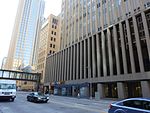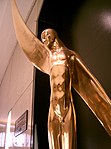Nicollet Mall station

Nicollet Mall is a light rail station on the METRO Blue Line and Green Line in Minneapolis, Minnesota. Adjacent to the light rail platforms is the southbound METRO Orange Line bus rapid transit station Marquette and 5th Street. This station is located on 5th Street South, between Nicollet Mall and Marquette Avenue in Minneapolis. This is a center-platform station with one westbound traffic lane south of the platform. Service began at this station when the Blue Line opened on June 26, 2004. In 2013 Metro Transit began constructing an additional northbound platform in conjunction with and as part of the Nic on Fifth apartment building. The additional platform was built to provide additional comfort and safety at the station, as well as alleviating overcrowding and providing additional capacity for Southwest LRT. While scheduled open March 2017, the new platform was opened December 22 later that year. It is the only station on the system where passengers can regularly board from either side of the train.
Excerpt from the Wikipedia article Nicollet Mall station (License: CC BY-SA 3.0, Authors, Images).Nicollet Mall station
South 5th Street, Minneapolis
Geographical coordinates (GPS) Address Website External links Nearby Places Show on map
Geographical coordinates (GPS)
| Latitude | Longitude |
|---|---|
| N 44.9785 ° | E -93.27 ° |
Address
Nicollet Mall
South 5th Street
55415 Minneapolis
Minnesota, United States
Open on Google Maps









